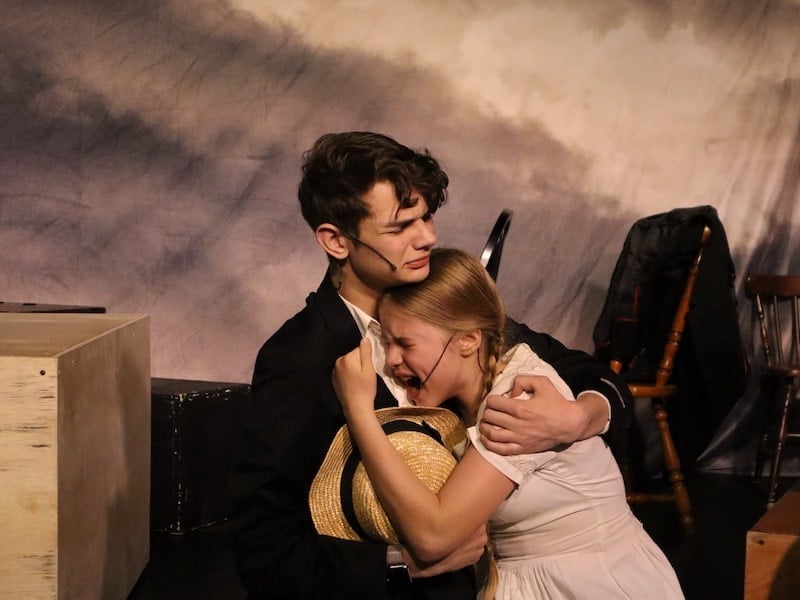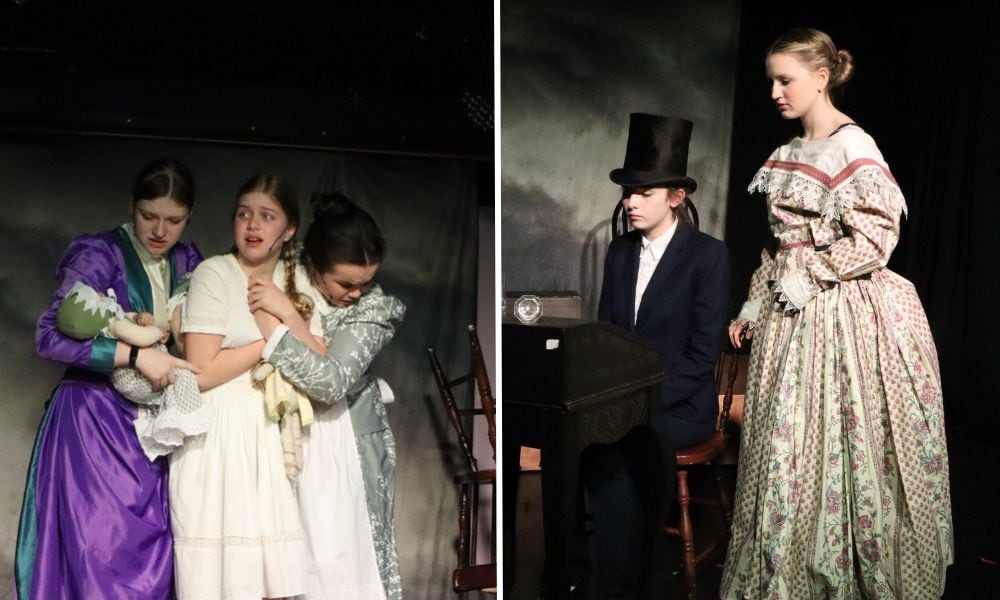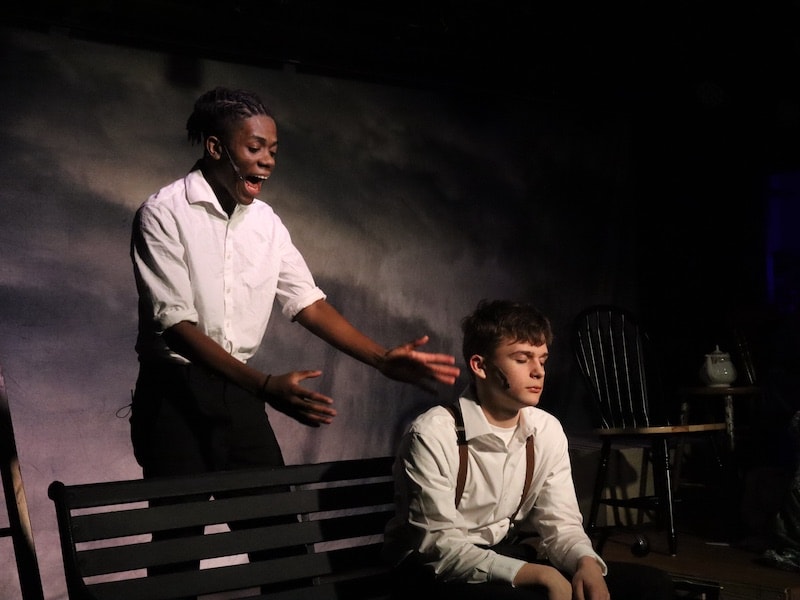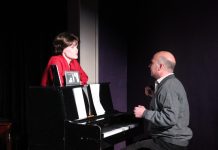Buskin is another name for the morose mask that along with its turn-a-frown-upside-down sibling forms the tragedy-comedy icon of the ancient Greeks. Actors in tragic roles wore buskins, a type of boot, marking them as grim, while their comic-relief counterparts traipsed around in thin, jester-like shoes called socks. Thus, the happy-sad “Sock and Buskin” remains the universal symbol for “Drama spoken here.”
StageCoach Theatre Company’s premiere two-act production of Into the Valley Below — a pioneering work written and produced mostly by Loudoun County high schoolers — is heavy on the boots. Prepare to be immersed in the tragic history of the Johnstown Flood of 1889, when a dam sloppily maintained by the idle rich burst, unleashing 20 million tons of water that decimated five lowland Pennsylvania towns and killed more than 2,200 mostly lower-class folks.

And these are killer boots. An ensemble of Victorian-adjacent, snappy footwear, with one crowning pair befitting a Greek-chorus character whose name is, fittingly, Tragedy. (On press night, a production tragedy was narrowly averted when a player broke her heel — the heel formerly attached to her shoe, that is, not her heel bone. Although some of the smart looks and booty-enhancing bustle dresses in stunningly ornate fabrics did have tricks up their sleeves, this was not a trick shoe.)
Tragedy (Izzy Jewell), grinning and grimacing in equal measure, has her counterpart not in comedy but in Memory (Heidi Dodd). The two narrators open and flow through the show like shadow emcees, introducing key characters, foreshadowing twists, delivering epitaphs. The effect is a history lecture brought to life.
And Potomac Falls High School senior Liliana “Lily” Rossi, co-author and co-director, certainly did her homework. With a script drowning in facts, this incarnation, expanded from her one-act The Great Johnstown Flood of 1889, performed at the International Fringe Festival in Scotland last summer, grants more breathing room. Alongside co-director Evan Gorman, Rossi has fleshed out characters, raising them above mere names on a Wiki page to painfully realize their plights. (Potomac Falls performing arts teacher Corinne Fox, who challenged this precocious playwright to create, shares writing credit.)
Setting the stage: Amid the land rush of 1889, back when there were only 38 loosely united states, Pittsburgh industrialists owned the land where the precarious South Fork Dam held back part of the Conemaugh River, forming a high lake where the leisure class pursued their leisure. As greedy capitalists are wont to do, they purportedly cut corners in repairing the dam, using cheap materials or cheap labor, and ignored warning signs of impending doom. Though the disaster later was ruled an “act of God,” the question arises whether it was willful negligence at the hands of men.
The set, awash in stormy blue, instantly portends danger. A ladder signals either escape or the figurative ascension to a higher plain. Platforms of different heights denote uneven tiers of society, the tallest seemingly reserved for the most privileged.
Performing almost exclusively at floor level are two standouts: lithesome Lily Cook, who fully inhabited young Gertrude Quinn on press night with gusto and guts (Tess Will at alternate performances); and Charles Fisher as her 16-year-old brother, Damian, a radiant and gifted actor whose generosity as a scene partner raised everyone else’s game. (Co-director Gorman steps in for half the performances.) In an early scene, before the water subsumes the sky, Fisher dives into a reverie about the blue Kansas dome and coverlet of constellations. His storytelling instincts are as bright as the savvy projections and lighting support supplied by Sarah Chung, Zoe Korff, and Aimee Wakefield.

Sound technician Daniel Prothe powers the story along by summoning incessant rain and a drumbeat of death, balancing stage whispers against horror-show screams.
In an attempt to inject more comedy into the proceedings, Victor Heiser (Liam Tully) shares with new buddy Damian his dream to become a doctor, wrapped in shaky wisecracks. Turns out the real-life Dr. Heiser was quite serious and made a name for himself, and Johnstown, as the de facto father of public health. He’s credited with saving millions of lives from another natural threat abetted by human behavior: infectious disease.
Among other notable performances were Sebastian Trujillo, skilled in pregnant pauses as a genial German immigrant (a Pennsylvania Dutch settler); Madi Saunders, who modeled expert pacing and diction in two supporting roles; Chris Shuffleton, wound tightly as worrywart James Quinn, who repeatedly cries wolf about the dam’s vulnerability; Claire “Cai” Reeps, whose calm, commanding presence as Aunt Abbie offsets Quinn’s fidgeting like an eye in the storm; and Emma Nicholson as the Quinns’ nursemaid, Libby. Poised and stalwart in her role, Nicholson proved the least steady on her feet, not only taking that terrifying spill from the damn shoe break but also tripping over a precariously placed set piece during the bows.

Amid all the calamity, I couldn’t help but draw parallels to my most beloved historical tragedy, which translated magnificently to the stage in 1997’s Tony-winning Titanic: A New Musical.
In Into the Valley Below, we meet the obstinate Benjamin Ruff (Mason Saunders), founder of the South Fork Fishing and Hunting Club, who, catering to the mountain retreat’s moneyed members, ordered the dam lowered and “fish guards” added while neglecting to install proper drainage in the event of a crisis. His Titanic doppelgänger? Bruce Ismay, the White Star Line’s chairman who pushed for faster speeds and fewer lifeboats in favor of bigger staterooms for first-class passengers.
In Valley, the railroad’s steam locomotive with “swanky Pullman cars” represents the Gilded Age’s industrial progress. The dam itself was a monstrous feat of engineering to tame coursing water, only stalling its vengeful course of history. Usher in the “unsinkable” Titanic, a floating city. When the doomed ship stops dead, bejeweled guests badger the crew and bemoan arriving late, not their unimaginable fate. Similarly, in Valley, high-society train riders are miffed when the train encounters a flooded track and nudge the conductor to make progress so they can keep their schedule, unaware their time for departure truly has come.

The telegraph is a vital lifeline in both shows. In Valley, Hettie Ogle (a polished Rahmah Hagmagid, who masters a semblance of Morse code along with patter-style dialogue) must monitor rain and water levels. She taps out warnings to telegraph offices in vain — akin to the unheeded warnings of iceberg sightings by Titanic’s faithful wireless operator. South Fork Dam company man John Parke (Mila Krsmanovic) turns into a frenzied town crier after the dam breach; Titanic’s architect is portrayed as maniacally redesigning the ship even after the hull is breached beyond hope. There are also parallel “lookouts”: Victor climbs atop his family’s barn, desperately spying a wall of water and debris approaching, while British sailor Frederick Fleet utters those famous, ill-timed words: “Iceberg, right ahead.”
Both works expose human foibles with grave consequences and plenty of blame to go around. And they unanimously prove that when civilization is pitted against the immovable force of nature — especially water, in all forms — mankind is no match.
Witnessing the denouements of Valley and Titanic makes for agonizing but cathartic second acts. In both shows, Act One indulges in the levity of humanizing historical figures, while Act Two reveals who among them shall survive. “This is the end of the world!” a voice peals. “It’s the valley of death!”
Disturbed, I left the Ashburn theater wondering, “Why on earth would a teenager choose such a grim story to tell?” The answer came quickly amid buckets of weekend rain. Here’s a new wave of talent from artists so young and raw but consigned to live in survivor mode. Gen Z, the post-9/11 generation, stands to inherit a last-man-standing planet pocked by record floods, fires, epi/pandemics, and a slew of untold disasters. This is the “say their names” generation — those paying witness to horrifically commonplace gun violence, hate crimes, and injustice imposed by people charged with defining or defending the law. They know the poetry in reciting a litany of martyrs’ names. They are the questioners. The modern inquisition.
And beyond being students, they’re our teachers.
Running time: Approximately two hours, including one 15-minute intermission.
Into the Valley Below plays through March 31, 2023, at StageCoach Theatre Company, located at 20937 Ashburn Road, Suites 115 and 120, Ashburn, VA. Tickets for in-person seating ($23) at press time were sold out, but live streaming ($23.95) is still available. Or you can call the box office at 571.477.9444.
The program for Into the Valley Below is online here.
COVID Safety: All guests may choose to wear masks while inside the theater, but it is not required. See StageCoach Theatre’s complete COVID protocols here.




